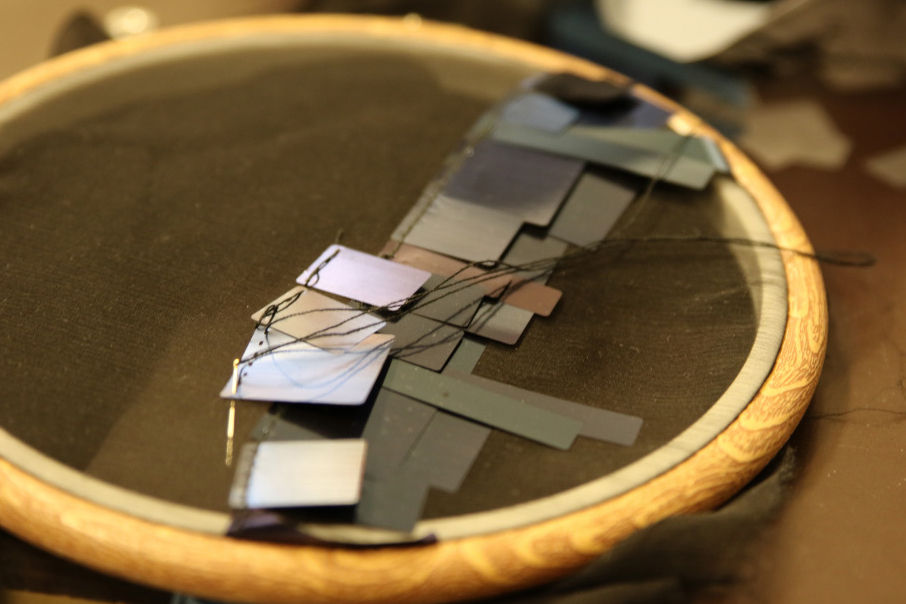A daring design that shows off the best of steel is the result of a collaboration between a Swedish fashion designer and an innovative steel manufacturer
When it comes to choosing the right outfit, the red carpet can be like running a gauntlet for even the most fashion conscious of celebrities. Now the choice has become yet more difficult as decadent materials and unthinking fashion trends are on the way out, while sustainability, local manufacturing and innovative materials are being championed.
This new approach to fashion ethics was represented in a bold choice seen on the red carpet of the Oscars earlier this year, where the woven train of a dress ensured that steel took a starring role.
Swedish fashion designer Naim Josefi’s haute couture creation used rolled steel embellishment in his design for film star actress Bahar Pars to wear to the Academy Awards ceremony in February 2017.
The actress was convinced by the designer’s use of innovative materials, saying, “an established fashion house would have given me a very nice dress, but I want to make a statement; to be on the creative forefront”.
Known for daring use of technical materials in his collections, this isn’t the first time Josefi has clothed celebrities in pieces made from or inspired by the properties of metal – Lady Gaga wore a 3D-printed plastic version of a line of shoes Josefi originally crafted from steel.
“I want to surprise, show the unexpected, move creativity forward. Sustainability is also very important to me, and as it is 100 % recyclable, steel is an obvious choice.”
Naim Josefi
Josefi’s dress for the Oscars is made from around 6,000 ultra-thin, rolled steel sequins, produced by manufacturer voestalpine Precision Strip AB in Sweden. Environmental impact is very important to the designer’s ethos, with pure aesthetics only informing part of the decision on what to use when choosing materials.
“I want to surprise,” says Josefi, “show the unexpected, move creativity forward. Sustainability is also very important to me, and as it is 100 % recyclable, steel is an obvious choice.”
Ian Jones, head of sales and vice managing director of voestalpine Precision Strip AB, explains how his company became involved with the project. “The voestalpine researchers in Munkfors were approached via Jernkontoret, the Swedish steel industry’s special interest group, and asked to provide some particularly thin strip steel for the designer,” he says.
 Each of the 6,000 razor-thin steel sequins was sewn on by hand
Each of the 6,000 razor-thin steel sequins was sewn on by hand
“He was so enthralled with the material that he expanded his concept and decided to use several shades of blue. Through a series of oxidation experiments, researchers were able to colour the 0.022mm-thick steel strip in different shades of blue.”
This unique dress, which features 18,000 sequins, was the centerpiece of Josefi’s Stockholm Fashion Week collection, with its delicate construction and colouring catching the eye. Ian Jones, whose company more traditionally sees their ultra-thin product used in scalpels, razors and small valves, jokes that the material for the dress was made using “black magic, like all the rest of our steel”.
Jones highlights the “complicated series of cycles of high precision cold rolling and annealing down to these ultra-thin gauges” that is required to produce this kind of steel which is thinner than silkworm silk.
“Through a series of oxidation experiments, researchers were able to colour the 0.022mm-thick steel strip in different shades of blue.”
Ian Jones, voestalpine Precision Strip AB
In a world where ‘fast-fashion’ has led to the lifecycle of some clothing lines being extremely short, Josefi’s approach is to create enduring outfits that can help to combat the perception that the fashion industry creates and disposes of products too quickly.
For Josefi, putting thought into the processes and materials behind fashion masterpieces can be just as important as the conception of the design itself. Collaborating with teams like the researchers at voestalpine has helped deepen his understanding of this aspect.
“All my collections are built on scientific research. Technology helps me realize complex ideas and thoughts,” he says.
Images: Swedish Fashion Council / Jernkontoret
Video: Jernkontoret